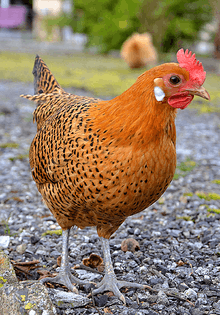Ostfriesische Möwe
The Ostfriesische Möwe, Dutch: Groninger Meeuw, is an old German breed of domestic chicken. It is a rare breed: in 2016 the recorded population in Germany consisted of 215 cocks and 979 hens, in the hands of 130 breeders.[1]:132 Its conservation status is gefährdet, "endangered".[1]:132
Gold hen | |
| Country of origin | Germany |
|---|---|
| Traits | |
| Weight |
|
| Egg color | white |
| Classification | |
| |
Silver hen

Gold bantam hen
History
The Möwe derives from the traditional rural chickens of north-western Germany and north-eastern Holland, in East Friesland and West Friesland respectively. It is closely related to the Westfälische Totleger and the Braekel.
Characteristics
It is kept in two colour varieties: silver-pencilled and gold-pencilled. Cocks weigh up to 3 kg and hens up to 2.5 kg. Hens lay about 170 eggs per year, averaging 55 g in weight.[1]:132
gollark: Neat, better than expected.
gollark: On MonkeyType, ~130WPM because it doesn't make me do silly things like "punctuation" and "caps".
gollark: <@528237610943119381> This is on my actual keyboard with 450k.
gollark: Like I said, phone bad.
gollark: 43WPM (adjusted) at a bad 89% accuracy.
References
| Wikimedia Commons has media related to Ostfriesische Möwe. |
- Einheimische Nutztierrassen in Deutschland und Rote Liste gefährdeter Nutztierrassen 2017 (in German). Bundesanstalt für Landwirtschaft und Ernährung. Accessed September 2018.
This article is issued from Wikipedia. The text is licensed under Creative Commons - Attribution - Sharealike. Additional terms may apply for the media files.